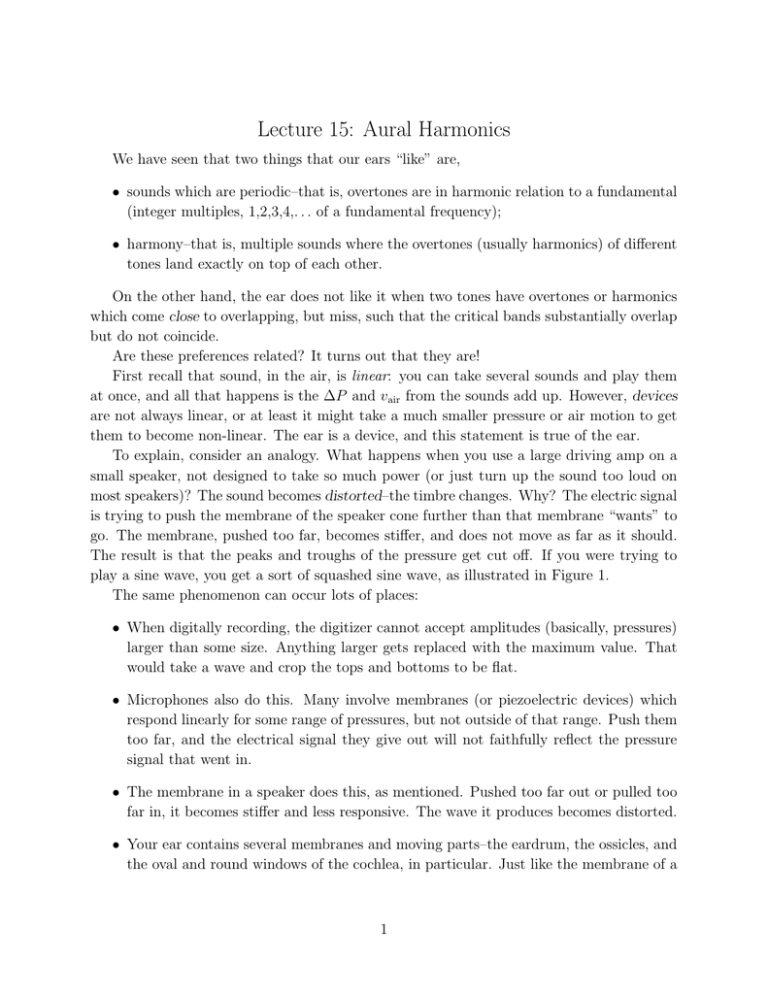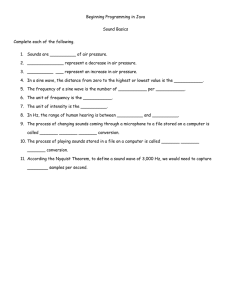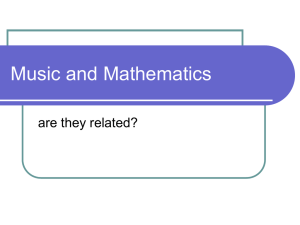Lecture 15: Aural Harmonics
advertisement

Lecture 15: Aural Harmonics We have seen that two things that our ears “like” are, • sounds which are periodic–that is, overtones are in harmonic relation to a fundamental (integer multiples, 1,2,3,4,. . . of a fundamental frequency); • harmony–that is, multiple sounds where the overtones (usually harmonics) of different tones land exactly on top of each other. On the other hand, the ear does not like it when two tones have overtones or harmonics which come close to overlapping, but miss, such that the critical bands substantially overlap but do not coincide. Are these preferences related? It turns out that they are! First recall that sound, in the air, is linear: you can take several sounds and play them at once, and all that happens is the ∆P and vair from the sounds add up. However, devices are not always linear, or at least it might take a much smaller pressure or air motion to get them to become non-linear. The ear is a device, and this statement is true of the ear. To explain, consider an analogy. What happens when you use a large driving amp on a small speaker, not designed to take so much power (or just turn up the sound too loud on most speakers)? The sound becomes distorted–the timbre changes. Why? The electric signal is trying to push the membrane of the speaker cone further than that membrane “wants” to go. The membrane, pushed too far, becomes stiffer, and does not move as far as it should. The result is that the peaks and troughs of the pressure get cut off. If you were trying to play a sine wave, you get a sort of squashed sine wave, as illustrated in Figure 1. The same phenomenon can occur lots of places: • When digitally recording, the digitizer cannot accept amplitudes (basically, pressures) larger than some size. Anything larger gets replaced with the maximum value. That would take a wave and crop the tops and bottoms to be flat. • Microphones also do this. Many involve membranes (or piezoelectric devices) which respond linearly for some range of pressures, but not outside of that range. Push them too far, and the electrical signal they give out will not faithfully reflect the pressure signal that went in. • The membrane in a speaker does this, as mentioned. Pushed too far out or pulled too far in, it becomes stiffer and less responsive. The wave it produces becomes distorted. • Your ear contains several membranes and moving parts–the eardrum, the ossicles, and the oval and round windows of the cochlea, in particular. Just like the membrane of a 1 Figure 1: Example of how a sine wave gets distorted if a speaker membrane simply cannot move as far as it needs to, to produce the desired sine wave. speaker, they are designed so that if you push twice as hard, they move twice as far– within limits. Push them too far, and their motion tends to be less than it “should,” because they get stiffer. So what? Well, suppose the input sound is a sine wave. The output sound is distorted, typically by having the tops and bottoms trimmed, not necessarily by the same amount. That is no longer a sine wave. However, it is still a periodic wave. That means that harmonics get added to the wave, which were not present to begin with. This happens in the membranes and bones of the ear on the way to the cochlear fluid. So if you play a sine wave, what arrives in the cochlea is not a sine wave, but distorted. The distortion is always the addition of harmonics with integer related frequencies (that is, play 300 Hertz, and the generated extra sine waves have frequencies of 600, 900, 1200, etc Hertz). These added harmonics are called aural harmonics, since they are harmonics added by the ear. The louder the original sound, the less linear the response–which means that, in terms of decibels, the aural harmonics get closer to the loudness of the original tone. As usual, the size of the aural harmonics also varies with frequency, though not that strongly. A reasonable approximation is that for a 70 dB tone, the 2’nd harmonic (twice the frequency) is 25 dB loud, and the 3’rd harmonic (three times the frequency) is 15 dB loud. Further, every 10 dB added to the fundamental adds 20 dB to the 2’nd harmonic and 30 2 dB to the 3’rd harmonic: for an 80 dB tone, the 2’nd harmonic is 45 dB loud, and the 3’rd harmonic is 45 dB loud. This helps explain something we saw two lectures ago. When we looked at the masking curves of a tone, say, 1000 Hertz, it was fairly symmetric for quiet intensities, but at very loud intensities it developed big peaks at twice and three times the frequency being played. That is because the aural harmonic of the loud tone can cover up the softer tone. What does it all have to do with our preference for periodic sounds? Suppose you had some sound which was not periodic. It was built out of sine waves, but the higher frequency sine waves (called overtones) did not appear at integer (1,2,3,. . .) multiples of the lowest tone. (This happens for primitive percussion instruments, for instance.) Then, if the sound were played loudly, the fundamental would also add its aural harmonics, which would be at exact multiples of the lowest frequency. For instance, if the instrument played 500 Hertz plus 1050 Hertz sine waves, then the 500 Hertz sine wave would add an aural harmonic at 1000 Hertz. 1000 and 1050 Hertz are dissonant, because they are too close together to excite separate regions on the cochlea, but not close enough together to hit exactly the same spot. Therefore, they sound “ugly” or dissonant. An instrument which makes sounds like this would be discarded (or used for special dissonant effects). On the other hand, if the overtone the instrument produced were at 1000 Hertz, that is, exactly twice the fundamental, then it would overlap with the aural harmonic of the fundamental, which your ear likes. Therefore, while we may not know why the ear/brain system “likes” consonance and “dislikes” dissonance, the fact that it “likes” periodic sounds is related to these facts. It turns out, luckily, that it is pretty easy to build instruments which produce periodic sounds. Most instruments which make a “sustained” sound (wind instruments, bowed strings, voice) produce periodic sounds. If you look at the design of other instruments (piano, guitar, percussion), it often revolves around getting the overtones to be as close to integer multiples of the fundamental as possible. For instance, as we will discuss when we talk about piano, the longer, thinner, and higher tension a plucked or hammered string is, the more harmonic the overtones. One of the reasons that upright pianos sound bad in their lower registers is that the strings are not producing harmonic overtones. Check to see whether an upright’s bottom octave sounds worse to you when played very loud (when the aural harmonics are important) than when played softly (when they are less prominent). 3



